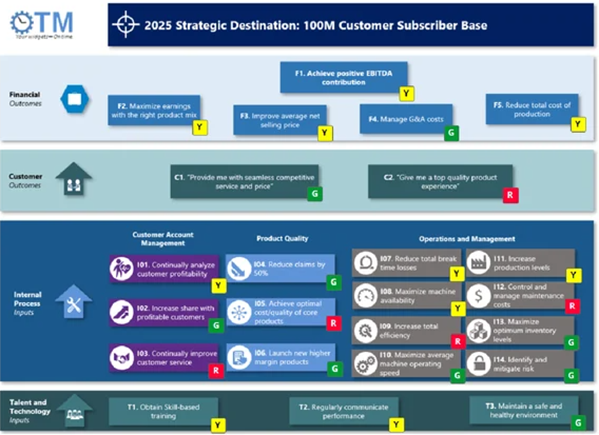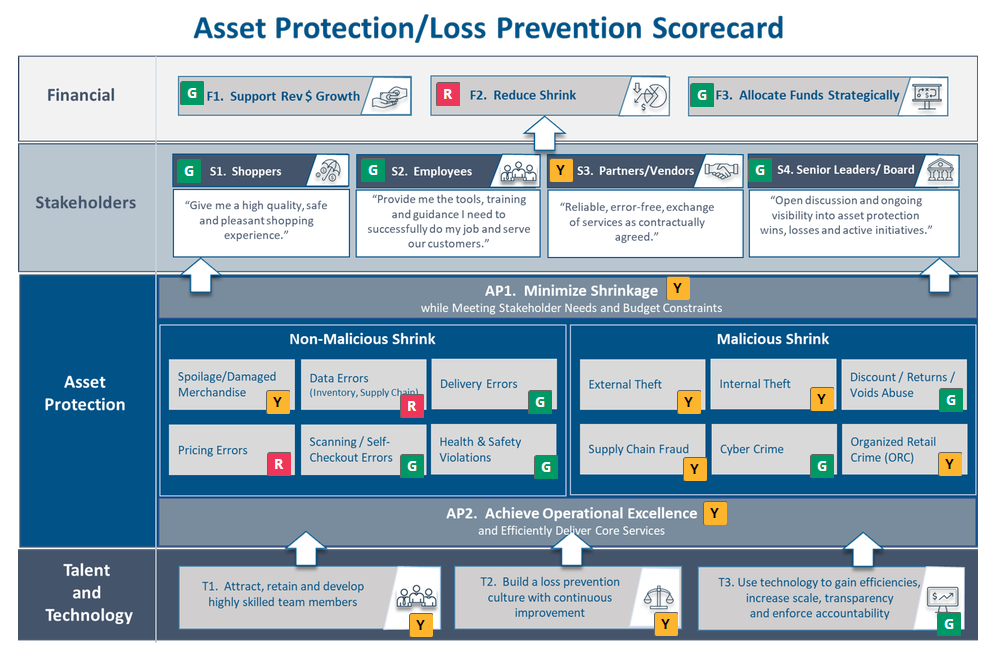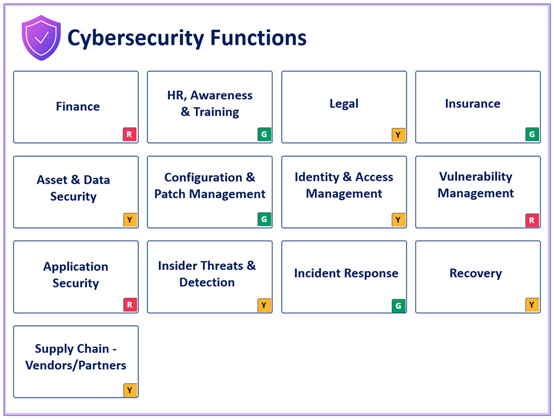Strategy maps are invaluable tools that help organizations navigate through the challenges of planning and executing their strategy. They make your strategy real by translating abstract ideas and objectives into a clear and understandable format that can be easily communicated up, down and across your organization. For decades, the strategy map construct has been successfully implemented and adopted by many of the world’s most well-known commercial, government, and non-profit organizations.
But before we go further, let’s start with a definition. A strategy map is a one-page visual representation of an organization’s strategy typically including objectives, or sometimes referred to as goals, that roll into four key perspectives: Financial, Customer, Internal Process, and Talent and Technology.
Translating your strategy onto a single page strategy map requires critical analysis and buy-in from key stakeholders. But it is worth the effort. A strategy map provides:
- Clarifies Strategy: Clarity helps ensure that everyone in the organization understands the strategic goals and how they connect to each other, fostering a unified approach to achieving those goals.
- Aligns Organizational Efforts: By illustrating how various goals and initiatives interconnect, strategy maps ensure that all parts of the organization work cohesively towards common objectives, minimizing duplication of efforts and ensuring resources are allocated efficiently.
- Facilitates Communication: Strategy maps serve as a powerful communication tool, making it easier for leaders to articulate the organization's strategy to stakeholders at all levels.
- Drives Performance Measurement and Management: By linking strategic objectives to specific performance indicators and measures (found on the Balanced Scorecard), strategy maps enable organizations to track progress towards their goals systematically.
Below is an example of a corporate level strategy map. It clearly articulates the strategy for a fictitious company OTM across the traditional four perspectives.

This strategy map will help OTM communicate the strategy across the organization. It will drive strategic performance reviews and ultimately, drive the organization towards its strategic destination. But this is the first step. Additional alignment can be established to motivate supporting units to actively engage with the strategy.
That’s where cascaded scorecards come in.
But organizations attempting to cascade their strategy across divisions and down through functions and departments often confront challenges. As they attempt to align their strategy deeper into the organization, practicality, execution, tactics, and nearer-term operational realities can take over. The focus often becomes hitting numbers and getting things done, whether those efforts contribute to accomplishing strategic objectives, or not.
Sometimes this causes a disconnect at a department/functional level. Teams might then begin to question the time spent versus benefit for tracking and measuring performance against high level objectives. In this blog, I intend to identify a better way to engage departments around the strategy for the benefit of all parties.
Departmental/Functional Strategy Maps and Why they are Important
The strategy map and scorecard don’t have to follow a rigid, one-size-fits-all approach, especially as you cascade through an organization. Rather, they should be tailored to the specific needs of each department or function to make them more useful while still allowing rollups of metrics and objectives to the corporate strategy. This will increase adoption at the department level as the exercise of data collection and recurring performance evaluation provides value to teams when measuring and tweaking their own performance.
The true value of departmental and functional level scorecards lies in their ability to be customized to the specific priorities, challenges, and operational realities of each unit, shifting away from merely repeating corporate level priorities and how they fit in.
A critical characteristic of these cascaded scorecards is that they actively reflect the day-to-day strategic work, often called initiatives, that keeps the organization running. This is where straying from the traditional approach comes in. Customization ensures that the strategies and objectives are relevant and directly applicable to the department or function, making execution more tangible and actionable.
- Tailored to Specific Priorities: Departmental and functional scorecards allow for a granular focus on what's most important to each unit. By identifying and tracking metrics that are directly linked to the department’s key objectives, these scorecards ensure that efforts are concentrated on areas that will have the most significant impact on performance. This targeted approach enhances the relevance of strategic initiatives, ensuring they resonate with the unique context and goals of each unit.
- Promotes Tactical Execution: Departmental and functional scorecards bridge the gap between high-level strategic goals and the tactical actions needed to achieve them. By breaking down overarching strategies into specific, measurable targets, these scorecards translate "pie in the sky" goals into concrete steps that can be acted upon in the short term. This focus on tactical execution helps to maintain momentum and keep teams engaged by providing clear, achievable milestones.
- Enhances Accountability and Empowerment: When scorecards are tailored to the operational scope of a division or functional area, it naturally fosters a sense of ownership and accountability among team members. Employees can see the direct impact of their work on outcomes, which empowers them to take initiative and drive results. This empowerment can lead to increased innovation and proactive problem-solving within divisions, further aligning daily activities with strategic objectives.
- Facilitates Agile Adaptation: Customized scorecards enable divisions and functions to respond more dynamically to changes in their specific environment. By focusing on metrics that matter most to their operations, units can quickly adjust their strategies and actions to address emerging challenges or capitalize on new opportunities. This agility is crucial for maintaining relevance and competitiveness in a rapidly evolving market.
A Better Way – Going Off Script
In my opinion, the traditional four perspectives that are foundational for a balanced approach at the corporate level become a little less useful at the division and functional level. But that doesn’t mean that organizations should not take advantage of strategy maps as they cascade down through the organization. That said, a slightly different approach is warranted.
Add New Perspectives to your Strategy Map
Don’ be afraid to add new perspectives to your strategy map if it adds clarity and details that help you to manage your function. Afterall, departments and functional areas within an organization face unique challenges and have unique operational responsibilities that extend beyond high level objectives that live on a corporate strategy map.
For example, the Asset Protection function often found within retail organizations is focused on reducing losses, minimizing risks and protecting organizational assets. Their strategy map may include an entire section that is dedicated to “Asset Protection“ while still maintaining other traditional perspectives as can be seen in the example below.

Build your Map Based on Key Functions that your Department Delivers
This approach creates a strategy map that is operationally focused and may or may not include perspectives at all. This enables a department to clearly identify and communicate those areas of responsibility that are most important to deliver their services for the organization. If they did not meet their commitment to deliver these, the company would be in trouble.
For instance, a Cybersecurity function is responsible for protecting the organization's digital assets, ensuring the integrity, confidentiality, and availability of data. Given these unique responsibilities, they could benefit from completely straying from the foundational corporate strategy structure to specifically tracking the key functional areas that they are responsible for delivering on a recurring basis. This might include areas like awareness and training, identity and access management, asset and data security, incident response etc.
And within each of these areas, there will be supporting measures and data metrics that are very specific to the functional disciple of cybersecurity. Clearly, these types of metrics do not belong on a corporate scorecard but are critical to evaluating the performance of a cybersecurity team. Some examples might include number of breaches, mean time to recover, supply chain partner contract reviews to name a few.
Not only is this logical, but by making the strategy map more specific and tactical will help to ensure adoption of the scorecards on an ongoing basis, which is critical to strategic success.

By relaxing the constraints of the traditional approach as we cascade through an organization, we can create meaningful strategy maps and scorecards that go beyond high-level longer-term aspirations. Scorecards that track specifically what a division is responsible for delivering. This makes the scorecard far more useful to management and team members who are responsible for delivery.
Considerations for Customization
While cascading your strategy is the approach we suggest, there are some considerations to keep in mind as you pursue this effort.
Maintain Alignment with Corporate Strategy: While customization is beneficial, it's important to ensure that division-level scorecards and their unique perspectives still align with and support the overarching corporate strategy. This alignment ensures that while divisions may pursue different paths, they all contribute to the organization's collective goals.
Balance Between Customization and Complexity: Adding custom perspectives can provide valuable focus, but it's essential to balance the benefits of customization with the potential for added complexity. Scorecards should remain clear and manageable to avoid overwhelming teams and diluting focus.
Continuous Review and Adaptation: As divisions evolve and strategic priorities shift, the relevance of certain perspectives may change. Regular reviews of the scorecard and its perspectives ensure they remain aligned with current objectives and operational realities.
Enhanced Alignment with Strategic Objectives: By allowing divisions to tailor or introduce new perspectives, organizations can ensure that the scorecard directly supports the strategic objectives most relevant to each division's role within the company. This customization enhances alignment and ensures that the scorecard is a living document that evolves with the division's strategic focus.
Increased Engagement and Ownership: When teams have the opportunity to shape their scorecard to reflect the realities of their work and strategic priorities, it fosters a greater sense of ownership and engagement. Custom perspectives can make the scorecard more meaningful and actionable for the team, increasing motivation and commitment to achieving defined objectives.
In Summary
While tremendous value can be derived from corporate strategy maps, cascading the strategy to divisions and functions can unlock even greater value for an organization. By going one step further, by creating customized divisional and functional level scorecards, organizations will make strategy execution more relevant, actionable, and adoptable.
Strategy maps and scorecards done right at this level provide the specificity and tactical focus necessary for translating broad organizational goals into meaningful, day-to-day actions that drive progress and success at every level of the organization.
Ultimately, the flexibility to adapt the strategy map construct by 1) including division-specific or functional area-specific perspectives or 2) starting over from scratch based on unique functional areas of importance to your department is a powerful approach. It allows for a more nuanced and effective application of strategic management practices, ensuring that strategy maps and scorecards are practical tools that drive meaningful action and results.
Want to talk to us about your cascaded scorecards and how we can help?





